When taking pictures using a macro lens, shallow depth of field usually mandates a rather small aperture to gain sharpness. With automatic lenses, stopping down is not a problem because the camera keeps the aperture wide open during view finding, unless you press the depth of field preview button. Only when camera is taking a picture, does it set the true aperture to whatever you set it to for exposure. However, if you ever used a manual macro lens, stopping down the lens cuts the light significantly, making it really hard to see through the view finder and focus. This is particularly hard for higher magnification macro lenses such as Canon MP-E 65mm f/2.8, Laowa 60mm f/2.8 2x and lenses on extension, etc, where it is almost impossible to focus even at f/11.
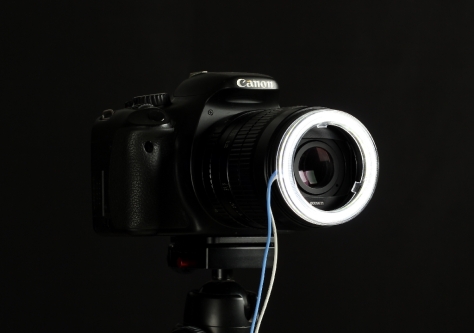
Good news is that there is a simple and easy to do DIY solution to this problem as shown above and the difference can be day and night.
There are several features a focus assist light for macro lens must have. The first one is that the light must be very thin and small because most macro lenses have relatively short working distance, in range of several centimeters or a couple of inches. If the focus assist light is too thick or too big, it will erode the precious working distance of macro lens. On the other hand, the short working distance also means we do not need very high powered light, so we do have an advantage. The second feature a focus assist light for macro lens is that it must be continuous, and being continuous means the light itself must consume as little power as possible in order for it to be practical.
LED Ring Light
Being an advocate of LED lights, naturally I thought of using or modifying an existing LED light and best of all, I have seen one good candidate for such light — something called Angel Eyes for car headlight decoration. Not only this type of LED ring light is suitable for our application, some of them even comes with right size and a plastic cover for diffusion. Quick eBay search with term LED Angle Eyes 60mm Plastic Cover yields enough such lights.
I am lucky that I have access to one such light in brick and mortar store where I can quickly evaluate if a light is fit or not.
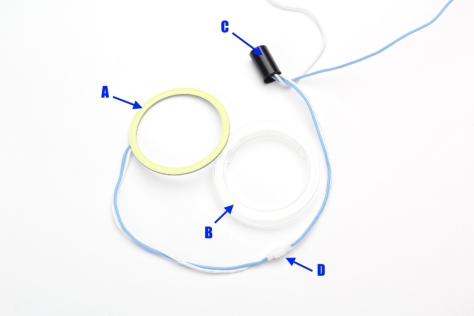 A – COB LED ring light, B – Plastic Cover, C – Voltage Regulator, D – a cconnector
A – COB LED ring light, B – Plastic Cover, C – Voltage Regulator, D – a cconnector
The LED ring light A shown in above picture is something called COB (chip on board) LED, it is very uniform when powered up. The plastic cover, B, which can be put over the LED and further diffuse the light and protect the LED. There is also some kind of voltage regulator, shown as C in above picture, it is not needed at all, so it will be cut off. There is also a connector, D that can be used as power switch or other purposes, so it will be useful/.
This particular light shown below has 60mm outer diameter and its plastic cover has approximately 49mm inner diameter. Luckily, it is easy to find a 62-to-49 filter adapter ring on the market and the plastic cover seems just right to clip it onto a 62-to-49 ring. If you have a macro lens, such as Canon MP-E 65, with 58mm filter thread, use a 58-to-49 step down ring instead.
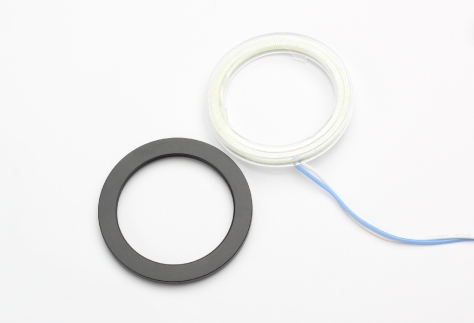
A 62-to-49 step down filter adapter ring and the LED ring light with plastic cover. If your macro lens has 58mm filter thread, then a 58-to-49 step down ring can be used instead.
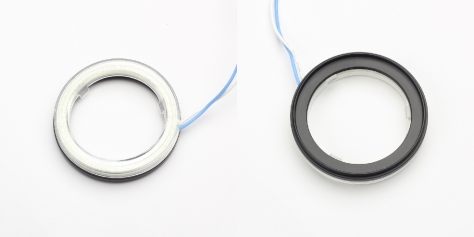 Front and back of finished LED ring light assembly. Notice the back view, the plastic cover clips on the 62-to-49 (or 58-to-49) ring nicely.
Front and back of finished LED ring light assembly. Notice the back view, the plastic cover clips on the 62-to-49 (or 58-to-49) ring nicely.
Power Supply
Because these lights are designed for cars and they are supposedly used in that environment, the power supply requirement is 12V, the voltage for most car battery. However, my goal is to power it using commonly found and less bulky AA batteries. I have a battery box that can hold 4 AA batteries, so it will be used as power source.
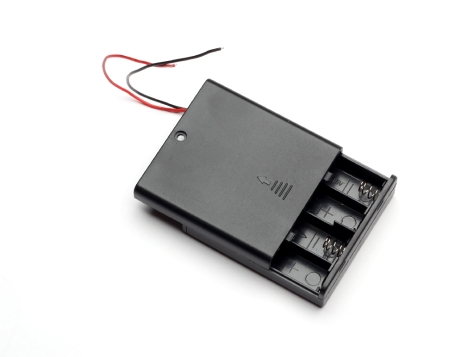 A battery box to hold 4 AA batteries. This particular box also has a on-off switch that can be really helpful
A battery box to hold 4 AA batteries. This particular box also has a on-off switch that can be really helpful
So in order to boost voltage high enough to power the LED ring light, an DC-DC voltage booster is needed to raise 4.5V to 6V (4 AA batteries at various stage of usage) to approximately 12V (actual voltage will be determined later). Again, we look to eBay and a quick search of the term DC-DC Boost Buck Step Up returns a number of such device and they are cheap. This is the one I am using to achieve voltage boosting.
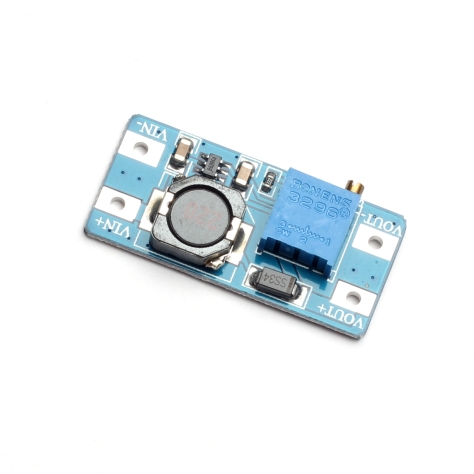 This is a cheap but reliable DC-to-DC voltage booster works very well. The blue blocky thing is a potentiometer, it is used to adjust output voltage and once output voltage is set, it will remain constant regardless input voltage from the 4 AA batteries. This is important to maintain constant lightness regardless how used up the 4 AA batteries is. Of course, there is a limit where this device just can not keep up the voltage and that is when the batteries need to be replaced.
This is a cheap but reliable DC-to-DC voltage booster works very well. The blue blocky thing is a potentiometer, it is used to adjust output voltage and once output voltage is set, it will remain constant regardless input voltage from the 4 AA batteries. This is important to maintain constant lightness regardless how used up the 4 AA batteries is. Of course, there is a limit where this device just can not keep up the voltage and that is when the batteries need to be replaced.
This particular device is a little hard to adjust when I first got it — it is a multi-turn pot and to get it to work, you have to turn many time. So here is the EXACT procedure to do it else you might think it is a defective one, it happened to me :
- put the device down and let the copper pole of the pot face to your right
- use a multi-meter to measure the output voltage, by default, it usually shows whate ever the voltage is from the 4 AA batteries
- use a screw driver to turn it counter-clockwise until voltage changes
- turn until voltage reaches about 8.3 volts, this is the voltage that will make the LED light bright enough to be focus assist light and still not too bright to consume too much power
Since this device has markings on it that clearly indicate what is what, it is rather easy to wire it up: VOUT+ to the positive lead (white wire) of LED light, VOUT- to the negative or ground lead (light blue wire) of the LED light, VIN+ to the positive wire (red wire) from battery box and VIN- to the negative or ground wire (black wire) from battery box.
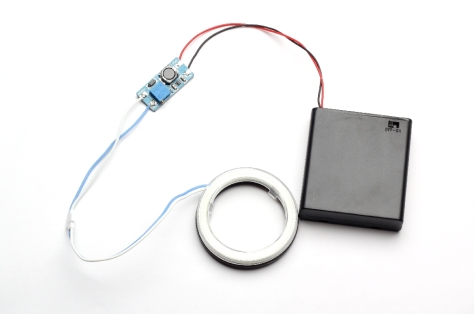 Finished wiring and is ready to use. However wrapping the voltage booster with electric tape is highly recommended.
Finished wiring and is ready to use. However wrapping the voltage booster with electric tape is highly recommended.
Note for different LED brand, the color of wire might be different and some quick tests are needed. If you do not know exactly which wire is positive and which is negative, you can touch the wires to the VOUT+ VOUT- of the voltage booster quickly to determine the right wiring.
Conclusion
Though it is a bit complicated, it is worth the effort to build one if you want to get sharp images in the field because with the focus assist light, even at f/22, you can see things and focus much better.

very nicely done thank you for sharing
LikeLike
Some options:
1) Use only 3 batteries, and put the voltage changer inside the box. They vary, but most will work OK from the 3.6-4V you get
2) You could use a battery box designed to hold 8 batteries, and house the voltage changer inside that, with the adjuster accessible if you wanted. You could use 4, or say 6 batteries.
3) Those voltage shifters are also available with a Micro USB socket, you so could use a phone charger instead of batteries (or a power bank)
LikeLiked by 1 person
Great ideas, I did not use voltage shifters to make things “easy”.
LikeLike